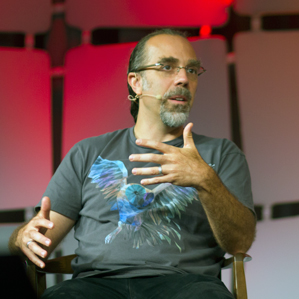EmTech: Google’s Internet “Loon” Balloons Will Ring the Globe within a Year
Within a year, Google is aiming to have a continuous ring of high-altitude balloons in the Southern Hemisphere capable of providing wireless Internet service to cell phones on the ground.

That’s according to Astro Teller, head of the Google X lab, the company established with the purpose of working on “moon shot” research projects. He spoke at MIT Technology Review’s EmTech conference in Cambridge today.
Teller said that the balloon project, known as Project Loon, was on track to meet the goal of demonstrating a practical way to get wireless Internet access to billions of people who don’t have it today, mostly in poor parts of the globe.
For that to work, Google would need a large fleet of balloons constantly circling the globe so that people on the ground could always get a signal. Teller said Google should soon have enough balloons aloft to prove that the idea is workable. “In the next year or so we should have a semi-permanent ring of balloons somewhere in the Southern Hemisphere,” he said.
Google first revealed the existence of Project Loon in June 2013 and has tested Loon Balloons, as they are known, in the U.S., New Zealand, and Brazil. The balloons fly at 60,000 feet and can stay aloft for as long as 100 days, their electronics powered by solar panels. Google’s balloons have now traveled more than two million kilometers, said Teller.

The balloons provide wireless Internet using the same LTE protocol used by cellular devices. Google has said that the balloons can serve data at rates of 22 megabits per second to fixed antennas, and five megabits per second to mobile handsets.
Google’s trials in New Zealand and Brazil are being conducted in partnership with local cellular providers. Google isn’t currently in the Internet service provider business—despite dabbling in wired services in the U.S. (see “Google Fiber’s Ripple Effect”)—but Teller said Project Loon would generate profits if it worked out. “We haven’t taken a dime of revenue, but if we can figure out a way to take the Internet to five billion people, that’s very valuable,” he said.
Keep Reading
Most Popular
Large language models can do jaw-dropping things. But nobody knows exactly why.
And that's a problem. Figuring it out is one of the biggest scientific puzzles of our time and a crucial step towards controlling more powerful future models.
The problem with plug-in hybrids? Their drivers.
Plug-in hybrids are often sold as a transition to EVs, but new data from Europe shows we’re still underestimating the emissions they produce.
How scientists traced a mysterious covid case back to six toilets
When wastewater surveillance turns into a hunt for a single infected individual, the ethics get tricky.
Google DeepMind’s new generative model makes Super Mario–like games from scratch
Genie learns how to control games by watching hours and hours of video. It could help train next-gen robots too.
Stay connected
Get the latest updates from
MIT Technology Review
Discover special offers, top stories, upcoming events, and more.